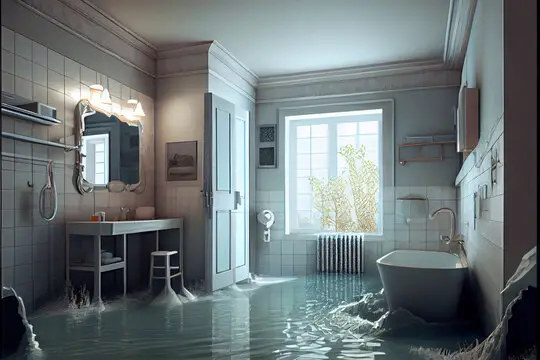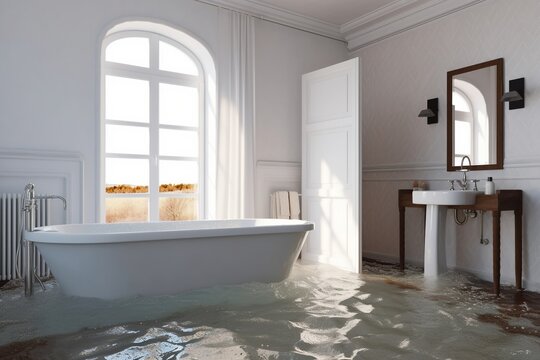Why Is My Bathroom Flooding? Exploring Common Causes and Solutions
Have you ever walked into your bathroom, only to find it flooded with water, causing panic and frustration? A flooding bathroom can be a distressing experience, and understanding the root causes can help you prevent it from happening again. In this comprehensive guide, we’ll delve into the common reasons behind bathroom flooding and provide practical solutions to keep your bathroom dry and functional.
Understanding the Causes of Bathroom Flooding
Bathroom flooding can occur for various reasons, ranging from minor issues to more significant plumbing problems. Let’s explore some of the common culprits:
1. Blocked Drains and Pipes
One of the most frequent causes of bathroom flooding is blocked drains or pipes. Hair, soap scum, and debris can accumulate over time, obstructing the flow of water and leading to backups.
Solution: Use drain covers and regularly clean your drains using a drain snake or a mixture of baking soda and vinegar to prevent clogs.
2. Overflowing Toilet
An overflowing toilet is a distressing sight. It can happen due to a blockage in the toilet trap or sewer line, causing water to spill onto your bathroom floor.
Solution: If your toilet begins to overflow, immediately turn off the water supply to the toilet by closing the shut-off valve. Plunge the toilet to remove the blockage or call a plumber for assistance.
3. Leaking or Burst Pipes
Leaking or burst pipes can lead to significant water damage in your bathroom. Pipe damage can result from freezing temperatures, corrosion, or wear and tear.
Solution: Shut off the main water supply to your home and contact a plumber to repair or replace the damaged pipes.
4. Faulty Toilet Components
Toilets have various components that can malfunction over time. A malfunctioning float valve or fill valve can cause continuous water flow into the toilet bowl, leading to overflow.
Solution: Inspect and replace faulty toilet components promptly to prevent overflow issues.
5. Poorly Sealed Bathtub or Shower
Inadequate caulking and sealing around the bathtub or shower can allow water to seep through the gaps, leading to leaks and eventual flooding.
Solution: Re-caulk and reseal the area around your bathtub or shower regularly to maintain a watertight seal.
6. Faulty Faucets or Fixtures
Leaky faucets or fixtures can waste water and potentially cause flooding if not repaired promptly.
Solution: Repair or replace leaking faucets and fixtures to prevent water wastage and potential flooding.
Preventing Bathroom Flooding: Tips and Maintenance
Now that we’ve explored the common causes of bathroom flooding, let’s look at preventive measures and maintenance tips to keep your bathroom dry and disaster-free:
- Regular Inspection: Conduct routine checks of your bathroom plumbing, including pipes, faucets, and fixtures, to catch and address issues early.
- Proper Drain Care: Install drain covers to prevent debris from entering the drains, and clean them regularly. Avoid flushing items that can cause clogs, such as wipes or sanitary products.
- Toilet Maintenance: Test your toilet components for proper functioning and replace any worn-out parts. Keep a plunger on hand to address minor blockages.
- Sealing and Caulking: Maintain a watertight seal around your bathtub, shower, and sink by re-caulking as needed. Check for any signs of water damage.
- Temperature Control: In cold weather, insulate exposed pipes to prevent freezing and potential bursting. Maintain a consistent indoor temperature to prevent freezing issues.
- Emergency Preparedness: Familiarize yourself with the location of shut-off valves for your toilet, sink, and main water supply. In case of a plumbing emergency, quick action can prevent extensive damage.
When to Seek Professional Help
While some bathroom flooding issues can be resolved through DIY efforts, others require professional intervention. Here are signs that indicate it’s time to call a plumber:
- Persistent blockages: If you’re constantly dealing with clogged drains or toilets, a plumber can diagnose and address the underlying issues.
- Low water pressure: Reduced water pressure can indicate pipe or water supply problems that require professional assessment.
- Visible leaks: If you notice water stains on walls or ceilings below your bathroom, it’s crucial to have a plumber inspect and repair any hidden leaks.
- Sewer line issues: Foul odors, gurgling sounds, or multiple drain backups can signal sewer line problems that demand professional attention.
Why is my bathroom flooding near the shower or bathtub?
Frequent flooding near the shower or bathtub may be due to poorly sealed or deteriorated caulk or grout. Water can seep through gaps and cause leaks.
Solution: Regularly re-caulk or reseal the area around your shower or bathtub to prevent water from escaping.
What should I do if my toilet overflows frequently?
Frequent toilet overflows can result from clogs or faulty components. Start by using a plunger to clear minor clogs. If the problem persists, consider inspecting and replacing malfunctioning toilet components.
How To Remove Limescale From Bathroom Tiles
Can a blocked drain cause bathroom flooding?
Yes, blocked drains can lead to bathroom flooding. Hair, soap scum, or foreign objects can clog drains, causing water to back up.
Solution: Use drain covers and clean your drains regularly to prevent blockages.
Is a leaking faucet a common cause of bathroom flooding?
A leaking faucet may not directly cause flooding but can waste water and increase your water bill. It’s essential to address faucet leaks promptly to prevent water wastage.
What should I do if I notice water stains on my bathroom walls or ceiling?
Water stains on walls or ceilings below your bathroom indicate a potential leak. It’s crucial to have a professional plumber inspect and repair any hidden leaks to prevent further damage.
Can bathroom flooding lead to mold growth?
Yes, bathroom flooding can create a conducive environment for mold growth due to moisture. Mold can develop within 24 to 48 hours of exposure to water.
Solution: Address any bathroom flooding promptly to prevent mold growth. Properly dry and ventilate affected areas to discourage mold formation.
How can I prevent bathroom flooding during heavy rains or storms?
To prevent bathroom flooding during heavy rains or storms, ensure that your bathroom’s drainage system, including gutters and downspouts, is clear of debris and properly functioning. Additionally, inspect the exterior of your bathroom for any leaks or vulnerabilities.
Are there insurance options to cover bathroom flooding damage?
Homeowner’s insurance policies may provide coverage for water damage caused by sudden and accidental events, such as burst pipes or appliance leaks. Review your policy and consider additional coverage for specific water-related risks.
What should I do if I discover a sewer line issue causing bathroom flooding?
Sewer line issues can be complex and require professional attention. If you suspect a problem with your sewer line, contact a plumber immediately to assess and resolve the issue.
Can a bathroom remodel help prevent future flooding incidents?
Yes, a bathroom remodel can provide an opportunity to address potential water-related issues. Upgrading plumbing fixtures, improving drainage systems, and ensuring proper sealing during a remodel can help prevent future flooding incidents.
Remember that addressing bathroom flooding promptly and taking preventive measures can save you from costly repairs and water damage. Regular maintenance and quick action in emergencies are key to maintaining a dry and functional bathroom.
How can I prevent bathroom flooding when I’m away from home for an extended period?
When leaving your home for an extended period, consider shutting off the main water supply or installing an automatic water shutoff valve. This can help prevent water damage in case of unexpected leaks or pipe bursts.
Can a faulty bathtub or shower faucet cause bathroom flooding?
Yes, a faulty faucet in your bathtub or shower can lead to continuous water flow, which may result in flooding. Inspect and replace malfunctioning faucet components as needed.
Is there a way to waterproof my bathroom to prevent flooding?
Waterproofing your bathroom during construction or renovation is an effective way to prevent flooding. Properly applied waterproofing membranes and seals can protect the underlying structures from water damage.
Can tree roots infiltrate bathroom plumbing and cause flooding?
Yes, tree roots can infiltrate sewer lines and cause blockages or pipe damage, which can lead to bathroom flooding.
Solution: Regularly inspect and maintain your sewer lines to prevent root intrusion. Consider professional tree root removal services if necessary.
How can I check for hidden leaks in my bathroom?
You can perform a simple water meter test to check for hidden leaks. Turn off all water sources in your home and monitor the water meter. If it continues to register water usage, there may be a hidden leak.
Solution: In case of suspected hidden leaks, hire a professional plumber to conduct a thorough inspection using specialized equipment.
Can high water pressure cause bathroom flooding?
Excessively high water pressure can stress plumbing fixtures and pipes, potentially causing leaks or burst pipes.
Solution: Install a pressure regulator on your main water supply line to maintain safe and consistent water pressure throughout your home.
How can I prepare my bathroom for the rainy season to prevent flooding?
Before the rainy season, ensure that your roof and gutters are in good condition to prevent roof leaks and excess water runoff. Inspect your bathroom for any existing leaks or vulnerabilities and address them promptly.
Are there DIY solutions for minor bathroom flooding issues?
For minor issues like small leaks or blocked drains, there are DIY solutions you can attempt. However, it’s essential to know your limitations, and if you’re unsure, it’s best to consult a professional plumber to avoid worsening the problem.
Can bathroom flooding lead to structural damage to my home?
Yes, if left unaddressed, bathroom flooding can cause structural damage to your home, including damage to walls, ceilings, and flooring. It can also promote mold growth, which can further compromise your home’s integrity.
What steps should I take immediately after discovering bathroom flooding?
If you discover bathroom flooding, your immediate steps should include shutting off the water supply to the affected area, if possible, and removing water using towels, a wet/dry vacuum, or a mop. Then, contact a plumber to identify and resolve the cause of the flooding.
Remember that prevention and quick action are key to dealing with bathroom flooding effectively. Regular maintenance, proactive measures, and knowing when to seek professional help can help you maintain a dry and functional bathroom space.
Conclusion
Bathroom flooding can disrupt your daily routine and lead to costly repairs if not addressed promptly. By understanding the common causes and taking preventive measures, you can minimize the risk of a watery catastrophe in your bathroom. Regular maintenance, quick action in emergencies, and knowing when to seek professional help are key to maintaining a dry and functional bathroom. So, bid farewell to bathroom floods and enjoy a stress-free bathing experience.


